On July 21, 1985, the center of power in Taiwan at the time, Taipei's Chungshan Hall (
The late Ku Cheng-kang (谷正綱), a staunchly anti-communist political protege of presidents Chiang Kai-shek (蔣介石) and Chiang Ching-kuo (蔣經國), was then serving as chairman of the Chinese Refugees Relief Association (CRRA, 中國災胞救助總會), and gathered a number of influential political and social celebrities to the meeting.
The CRRA was the official agency dealing with affairs concerning Chinese (including Tibetan) refugees from China. It hoped to build a grand Tibetan monastery (
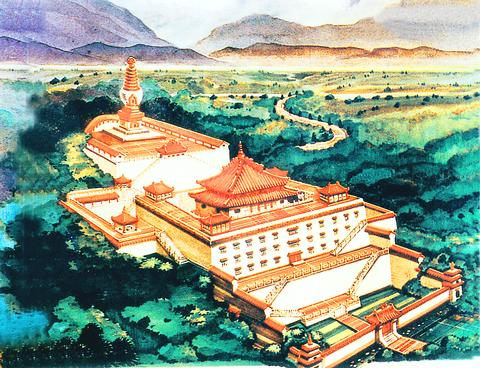
ILLUSTRATION: FRIENDS OF TIBET MAGAZINE
How to manipulate Tibetan politics in Taiwan's favor had always been a hotly-debated and sticky issue for the KMT government.
Although the KMT repeatedly proclaimed Tibet to be "an integral part of the Republic of China," adopting the same stance as its communist antagonist in Beijing, few Tibetans, exiled or not, agreed with this Chinese stance.
Ku, nicknamed the "anti-Communist Godfather," was a hard-line supporter of the KMT's unification policies and planned to set up a Tibetan power center in Taipei to compete with that of the exiled Dalai Lama in the northern Indian town of Dharamsala. A Tibetan monastery in Taipei, it was thought, would serve his purpose well.
Another important figure involved with the scheme was the head of the Mongolian and Tibetan Affairs Commission (MTAC,
Luring the Tibetans
Tung believed that, with the construction of a great monastery outside Tibet, the KMT would be able to come to terms with the Dalai Lama and, he hoped, lure him one day to Taiwan to turn the monastery into a center of worship for the Tibetan Buddhist diaspora.
Besides Ku and Tung, also present at this rare religious event, were Minister of the Interior Wu Poh-hsiung (吳伯雄), Legislator Lin Yu-hsiang (林鈺祥), Control Yuan member Lee Shen-yi (
Ku was elected chairman of the Tibetan Monastery Construction Committee and stated that the CRRA had agreed to offer 5,000 ping (approximately 16,000m2) of its own land at Wuchih Mountain (五指山) in Neihu, Taipei, to build the monastery.
Wu was elected vice-chairman of the committee.
Tung served as executive vice-chairman to work with Master Hsing Yun on fund-raising, with 18 others elected as standing committee members to oversee construction.
Sixteen years have passed and nothing seems to have come out of that religious gathering. A beautiful sketch map of the Tibetan Monastery, with a full report on the proceedings of the meeting, did, however, appear in the first issue (August 1985) of a now out-of-print magazine called Friends of Tibet (西藏之友), an official MTAC publication.
What went wrong with this apparently guaranteed construction project? More importantly, what happened to the construction funds?
According to Lee Hung-lieh (李鴻烈), the project's liaison officer and former director of the Tibetan Department of the MTAC, the Chinese Han-Tibet Culture Association, under the MTAC and chaired by Master Hsing Yun, was responsible for all fund-raising after Tung died from a sudden stroke in 1986, soon after the original meeting.
Lee was quoted in the media as saying: "Due to the fact that the committee failed to come up with enough funds to purchase the land offered by the CRRA, it had to leave all the fund-raising for Master Hsing Yun to generate through his social contacts. Unfortunately, he did not succeed and the project ran aground."
The CRRA thus decided to kill the plan when Ku died in 1993.
One interesting question is how much money the CRRA had asked for from the Monastery Construction Committee for the land at Neihu. Nobody, it seems, has an answer to that question.
The CRRA official's explanation might be just half the story. The other half seems to be that, after Tung's untimely death, a Mongolian, Wu Hua-peng (
Millions of
dollars missing
Other questions remain, however. How much money did the Monastery Construction Committee raise and where did the money go? Liu Hsu-tuan (
In March 1997, while the Dalai Lama was making his historic first visit to Taiwan, an official working for the MTAC told the Win Win Weekly (今周刊) that he understood that the total amount raised by the committee exceeded NT$16 million.
The actual amount raised and how the fund was managed have never been officially made public. It is troubling to note that the reported amount appears to have diminished with time.
About four years ago, Master Hsing Yun's secretary, Yung Chuang (永莊法師), said that Lama Tien had been in charge of the entire affair from the very beginning.
Yung Chuang further said that although Master Hsing Yun was the chairman of the Chinese Han-Tibetan Association, he did not actually know very much about the issue. Lama Tien would know best, he said.
When interviewed in 1997, Lama Tien said that the total amount raised for the project was slightly more than NT$5 million. The money had been deposited in bank and post office accounts, with the accounts specifically registered in the name "Tibetan Monastery." Lama Tien confirmed that the Construction Committee held a meeting in 1995, participants at which included representatives from the MTAC, and at which Tien was elected chairman.
Tien then offered his own explanation for the failure to build the monastery.
He said it was mainly tied to the land acquisition problem. The MTAC under Wu had instructed the Committee to organize a Mongolian and Tibetan Culture Center before Wu could ask the CRRA to release the designated land. He did exactly what was asked, but the application to acquire the land failed.
When the Taipei Times tried recently to contact Lama Tien again, he could no longer be reached. The office of the Chinese Han-Tibetan Association moved a few years ago from the Pumen Temple (普門寺) in Taipei and left no contact phone or address. The phone number of the association provided by the MTAC is not correct and there is no listed number for the association.
Since the Dalai Lama is on his second trip to Taiwan, the issue of the plan to build a Tibetan monastery is bound to come into focus as the relationship between Taipei and Dharamsala becomes more cordial.
There may be no need to sift through the old records to look for possible illegality. Nevertheless, the more than NT$5 million which has been sitting idly in the bank and post office for so many years deserves wiser management than to be left to be eroded by inflation or malpractice. Lama Tien cannot be reached and nobody seems to know of any new plan to allocate the unused funds.
The time for a new effort to construct a Tibetan Monastery in Taiwan seems ripe when one witnesses the overwhelmingly warm reception given to the Dalai Lama by the Taiwan public.
For the thousands of Tibetan Buddhist followers in Taiwan, a common worship center without the entanglement of Chinese politics is a sensible approach that would right the wrongs created when the monastery was bogged down in government red tape and, perhaps, the ill intention from certain individuals.
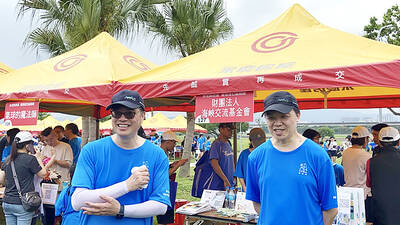
SECURITY: As China is ‘reshaping’ Hong Kong’s population, Taiwan must raise the eligibility threshold for applications from Hong Kongers, Chiu Chui-cheng said When Hong Kong and Macau citizens apply for residency in Taiwan, it would be under a new category that includes a “national security observation period,” Mainland Affairs Council (MAC) Minister Chiu Chui-cheng (邱垂正) said yesterday. President William Lai (賴清德) on March 13 announced 17 strategies to counter China’s aggression toward Taiwan, including incorporating national security considerations into the review process for residency applications from Hong Kong and Macau citizens. The situation in Hong Kong is constantly changing, Chiu said to media yesterday on the sidelines of the Taipei Technology Run hosted by the Taipei Neihu Technology Park Development Association. With
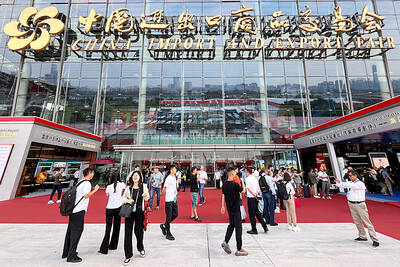
CARROT AND STICK: While unrelenting in its military threats, China attracted nearly 40,000 Taiwanese to over 400 business events last year Nearly 40,000 Taiwanese last year joined industry events in China, such as conferences and trade fairs, supported by the Chinese government, a study showed yesterday, as Beijing ramps up a charm offensive toward Taipei alongside military pressure. China has long taken a carrot-and-stick approach to Taiwan, threatening it with the prospect of military action while reaching out to those it believes are amenable to Beijing’s point of view. Taiwanese security officials are wary of what they see as Beijing’s influence campaigns to sway public opinion after Taipei and Beijing gradually resumed travel links halted by the COVID-19 pandemic, but the scale of
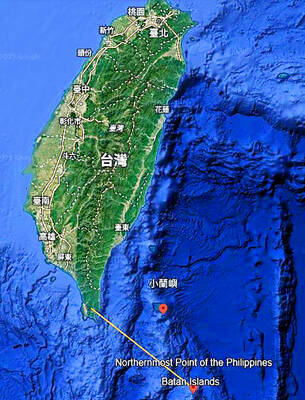
A US Marine Corps regiment equipped with Naval Strike Missiles (NSM) is set to participate in the upcoming Balikatan 25 exercise in the Luzon Strait, marking the system’s first-ever deployment in the Philippines. US and Philippine officials have separately confirmed that the Navy Marine Expeditionary Ship Interdiction System (NMESIS) — the mobile launch platform for the Naval Strike Missile — would take part in the joint exercise. The missiles are being deployed to “a strategic first island chain chokepoint” in the waters between Taiwan proper and the Philippines, US-based Naval News reported. “The Luzon Strait and Bashi Channel represent a critical access
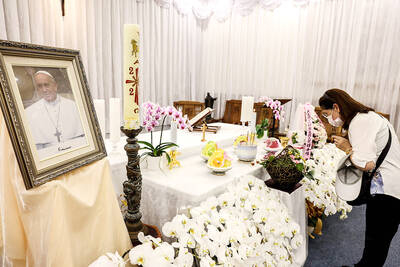
Pope Francis is be laid to rest on Saturday after lying in state for three days in St Peter’s Basilica, where the faithful are expected to flock to pay their respects to history’s first Latin American pontiff. The cardinals met yesterday in the Vatican’s synod hall to chart the next steps before a conclave begins to choose Francis’ successor, as condolences poured in from around the world. According to current norms, the conclave must begin between May 5 and 10. The cardinals set the funeral for Saturday at 10am in St Peter’s Square, to be celebrated by the dean of the College